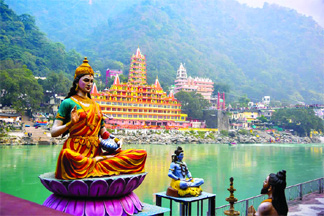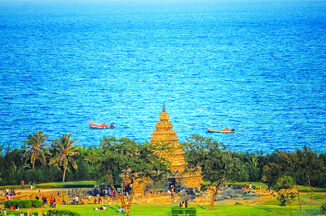
When you think of Bali, you probably picture golden beaches, coconut palms, and surfers chasing the perfect wave. But just a few hours away from the coast, a different Bali unfolds—one of misty mountains, emerald rice terraces, sacred temples, and rich cultural rituals. For the traveler willing to go beyond the beaches, Bali’s true soul awaits in its villages, jungles, volcanoes, and centuries-old traditions.
This is your guide to exploring Bali beyond the shoreline—an island of spiritual wonder, living heritage, and breathtaking natural beauty.
Ubud: The Artistic and Spiritual Heart
Nestled among rice fields and dense forest, Ubud is often called the cultural capital of Bali—and for good reason. This is where art, spirituality, and community intertwine.
– Art & Culture: Explore local galleries like Agung Rai Museum of Art (ARMA) and Neka Art Museum, or visit traditional villages like Mas (wood carving) and Celuk (silverwork).
– Healing & Wellness: Ubud is also a wellness haven. Sign up for yoga at The Yoga Barn, enjoy a detox retreat, or consult a local balian (traditional healer).
– Nature & Adventure: Don’t miss the Tegalalang Rice Terraces, a stunning display of subak irrigation, or hike the Campuhan Ridge Walk for a scenic stroll through hills and valleys.
– Temples & Traditions: Visit Goa Gajah (Elephant Cave), a mystical sanctuary dating back to the 9th century, or witness a Barong dance performance, a traditional mythological show.
Temples of Time: Sacred
Sites and Ancient Wisdom
Bali has over 10,000 temples, but some of its most powerful are tucked away from the beach crowds.
– Pura Lempuyang: Known for the iconic “Gateway to Heaven” photograph, this temple complex sits on a mountain slope and requires a spiritual 1,700-step climb.
– Tirta Empul: A centuries-old water temple where pilgrims perform melukat, a holy water cleansing ritual believed to purify body and soul.
– Besakih Temple: Located on the slopes of Mount Agung, this is Bali’s mother temple and the largest, most important religious complex on the island.
– Ulun Danu Beratan: Floating gracefully on Lake Beratan, this picturesque temple honors Dewi Danu, the goddess of lakes and rivers.
These temples aren’t just attractions-they are living places of worship, integral to the daily rhythm of Balinese life.
Highlands, Volcanoes & Rainforests
If Bali’s beaches awaken your body, its interior landscapes awaken your soul.
– Mount Batur: Trek this active volcano in the pre-dawn hours to reach the summit for a spectacular sunrise. From the top, you’ll witness Lake Batur and the surrounding caldera bathed in early light.
– Sekumpul Waterfall: Arguably the most beautiful waterfall in Bali, hidden in the lush jungle of northern Bali. A trek through local villages and bamboo forests leads you to its dramatic twin cascades.
– Munduk & Bedugul: This cooler region in north-central Bali is known for coffee plantations, twin lakes (Buyan and Tamblingan), and mist-covered hills perfect for slow, immersive travel.
These lesser-visited highland areas are ideal for nature lovers, photographers, and those seeking tranquility.
Traditional Villages and Local Life
Bali’s cultural core is in its banjars (village communities) and the customs that have been passed down through generations.
– Penglipuran Village: A pristine, traditional village near Bangli, known for its orderly homes, bamboo architecture, and deep commitment to preserving Balinese Hindu culture.
– Tenganan: One of Bali’s oldest Bali Aga villages, where ancient traditions like double ikat weaving and unique social customs remain unchanged.
– Sidemen: A hidden gem in East Bali that offers terraced rice fields, artisan weavers, and homestays where you can immerse yourself in authentic rural life.
Here, you can learn how to make offerings, join a temple ceremony, or simply enjoy the warm hospitality of local families.
Culinary Journeys Off the Coast
Beyond beachside smoothies and seafood BBQs, Bali’s inland regions offer earthy, traditional cuisine that tells stories of the land.
– Farm-to-Table Dining: In Ubud and Sidemen, many restaurants source directly from nearby organic farms. Try bebek betutu (slow-cooked duck in banana leaves) or lawar (a spiced vegetable and coconut salad).
– Cooking Classes: Join a market tour and cooking class where you’ll learn how to prepare satay lilit, nasi campur, and fragrant Balinese spice pastes.
– Coffee & Cacao Trails: Tour plantations near Munduk or Kintamani and taste locally grown Bali coffee, chocolate, and even herbal tonics made from native plants.
Bali’s food is a mirror of its land: rich, layered, nourishing.
Festivals, Ceremonies, and Spirit of Bali
What sets Bali apart is its everyday spirituality. Life here is infused with ceremony, color, and reverence for both the divine and the natural world.
– Galungan & Kuningan: These festivals mark the victory of good over evil, with elaborately decorated penjor (bamboo poles) lining the streets.
– Nyepi (Day of Silence): Bali’s New Year is celebrated in complete silence. No lights, no travel, no noise-just reflection and renewal.
– Odalan: Temple anniversaries are celebrated all year round, with dance, music, and rituals. You’re likely to stumble upon one during your travels.
Even an ordinary day might include dozens of offerings-canang sari-arranged with care and gratitude for harmony between humans, spirits, and nature.
Travel Tips for Exploring Bali
– Best Time to Visit: April to October (dry season) is ideal for hiking and temple visits.
– Getting Around: Hire a local driver or rent a scooter for flexibility; inland roads are scenic but winding.
– Cultural Etiquette: Always wear a sarong and sash when visiting temples. Ask before taking photos during ceremonies.
– Where to Stay: Opt for eco-lodges, homestays, or wellness retreats in Ubud, Sidemen, or Munduk.





ymcqxg
b6bzks
j6auyv
fs6fpm
3z0yih
Dead written content, thankyou for information .
wbdqie
q4h7fn
0c2flt
azag9y
9vvz43
vdvq52
llljm0